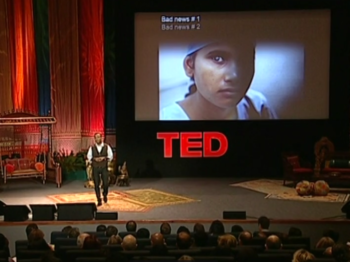Pawan Sinha’s “Vision in Art and Neuroscience”
2017 and 2018 Mellon Faculty Grant
Vision in Art and Neuroscience
About the Project
9.S52/9.S916 Vision in Art and Neuroscience introduces students to core concepts in visual perception through the lenses of art and neuroscience. Students will engage with these concepts through hands-on studio practice. The material has been selected both to expose students to the study of brain and cognitive sciences and to engage those already within the neuroscience community in art production as a means to explore and visualize the principles of perception. Through readings, lectures, discussions and project-based work, the course will explore the neural and computational mechanisms of vision and their parallel manifestations in visual art. The course aims to foster interdisciplinary dialogue between art and visual neuroscience, culminating in an exhibition of students’ semester-long projects.
The course treats the processes of visual perception and the creation of visual art in parallel. It proposes that the act of visual perception creates an internal representation of the external world and that the act of artistic creation depicts an external representation of the internal world.
Students will explore the hierarchy of visual processing from the moment that light strikes the retina to the internal experience of a rich visual world. In parallel, students will examine how each component of this process manifests in the experience of art, wherein the perceptual system observes itself. Using light as a medium and the darkroom as a canvas, students will externally visualize the stages of internal neural processing. Tutorials and training will give them the skills necessary to synthesize the material in their own artwork.
More information at the course website: Vision in Art and Neuroscience.
Presented by the MIT Center for Art, Science & Technology and the MIT Department of Brain and Cognitive Sciences.
Schedule
Past Events
Course 9.S52/9.S916
Offered Fall 2018
MIT Museum Studio, 10-150
Symposium
Interstitial Illumination
April 26, 2019 / 1:00-5:00pm
MIT Museum Studio and Compton Gallery, 10-150
Exhibition
Perceiving Perception
An exhibition of visual experience – installations created in MIT’s first Vision in Art and Neuroscience course engage the constructive nature of perception. Curated by Sarah Schwettmann and Seth Riskin.
Opening Reception: December 12, 2017 / 6:00pm
Light refreshments and artist-scientist talks from the students behind the work
MIT Museum Studio and Compton Gallery, 10-150
Course 9.S52/9.S916
Offered Fall 2017
MIT Museum Studio, 10-150
Biography
Pawan Sinha is a professor of vision and computational neuroscience in the Department of Brain and Cognitive Sciences at MIT. He received his undergraduate degree in Computer Science from the Indian Institute of Technology, New Delhi, and his master’s and doctoral degrees from the Department of Computer Science at MIT. He was at the University of California, Berkeley, for the first year of his graduate studies.
Using a combination of experimental and computational modeling techniques, research in Sinha’s laboratory focuses on understanding how the human brain learns to recognize objects through visual experience and how objects are encoded in memory. The lab’s experimental work on these issues involves studying healthy individuals and also those with neurological disorders, such as autism. A key initiative of the lab is Project Prakash; this effort seeks to accomplish the twin goals of providing treatment to children with disabilities and also understanding the mechanisms of learning and plasticity in the brain.
Seth Riskin is the director and co-founder of the MIT Museum Studio and the Manager of the Holography and Spatial Imaging Initiative and the Emerging Technology Initiative at the MIT Museum. Riskin’s background includes a BFA in Painting and Drawing from Ohio State University.
Riskin earned his SM in Visual Studies from the Center for Advanced Visual Studies at MIT in 1989. Combining his visual art and athletic ability, he originated a unique art form called Light Dance. In his Light Dance performances, Riskin’s body-mounted light instruments enable him to articulate light effects through his body movements, “sculpting” space around viewers who find themselves within the “dance”. The artwork has been performed widely at venues such as India’s National Centre for the Performing Arts and the São Paulo Art Biennial.
Riskin’s research, described as “anthropology” of light, led him to India in 1993 on a Fulbright scholarship to study light through the lens of Hindu concepts and practice. His courses on light, such as The Architecture of Light and Light as an Artistic Medium, have been taught at MIT, the Rhode Island School of Design and other universities.
Sarah Schwettmann is a computational neuroscientist interested in the creativity underlying the human relationship to the world: from the brain’s fundamentally constructive role in sensory perception to the explicit creation of experiential worlds in art. Schwettmann conducts research on Intuitive Physics in MIT’s Department of Brain and Cognitive Sciences, where she is working toward a PhD degree as a National Science Foundation (NSF) Graduate Research Fellow. Previously, Schwettmann was a member of the Eagleman Laboratory for Perception and Action at Baylor College of Medicine and the Shouval Lab for Theoretical Neuroscience at University of Texas Health Science Center at Houston.
In the arts, Schwettmann uses her background in computation to create installations that explore the structure in human cognition and the nature of intelligence. Her work has been exhibited at FiftyThree in New York and at OPEN Gallery in Boston. Schwettmann holds BA degrees in Computational and Applied Mathematics and Cognitive Science from Rice University, where she was a Trustee Distinguished Scholar and a Century Scholar and taught courses on Engineering Computation and Women Leaders in STEM.
For more information, visit Pawan Sinha, Seth Riskin, Sarah Schwettmann.
In the Media
MIT News: Learning more about the brain
MIT News: 3Q with Sarah Schwettmann: The Interface Between Art and Neuroscience
American Psychological Association: Neuroscientist brings light to the blind – and to vision research
SciArt Magazine: Art in Vision and Neuroscience



